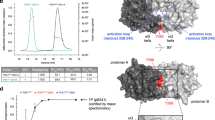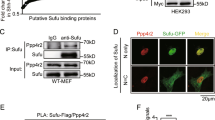Abstract
Pin1 regulates a subset of phosphoproteins by isomerizing phospho-Ser/Thr-Pro motifs via a ‘post-phosphorylation’ mechanism. Here, we characterize TR3 as a novel Pin1 substrate, and the mitogenic function of TR3 depends on Pin1-induced isomerization. There are at least three phospho-Ser-Pro motifs on TR3 that bind to Pin1. The Ser95-Pro motif of TR3 is the key site through which Pin1 enhances TR3 stability by retarding its degradation. Pin1 can also catalyze TR3 through phospho-Ser431-Pro motif, which is phosphorylated by extracellular signal-regulated kinase 2 (ERK2), resulting in enhanced TR3 transactivation. Furthermore, Pin1 not only facilitates TR3 targeting to the promoter of cyclin D2, a novel downstream target of TR3, but also promotes TR3 to recruit p300, thereby inducing cell proliferation. Importantly, we found that Pin1 is indispensable for TR3 to promote tumor growth both in vitro and in vivo. Our study thus suggests that Pin1 has an important role in cell proliferation by isomerizing TR3.
This is a preview of subscription content, access via your institution
Access options
Subscribe to this journal
Receive 50 print issues and online access
$259.00 per year
only $5.18 per issue
Buy this article
- Purchase on Springer Link
- Instant access to full article PDF
Prices may be subject to local taxes which are calculated during checkout






Similar content being viewed by others
References
Chang C, Kokontis J, Liao SS, Chang Y . (1989). Isolation and characterization of human TR3 receptor: a member of steroid receptor superfamily. J Steroid Biochem 34: 391–395.
Chen HZ, Zhao BX, Zhao WX, Li L, Zhang B, Wu Q . (2008). Akt phosphorylates the TR3 orphan receptor and blocks its targeting to the mitochondria. Carcinogenesis 29: 2078–2088.
Davis IJ, Hazel TG, Chen RH, Blenis J, Lau LF . (1993). Functional domains and phosphorylation of the orphan receptor Nur77. Mol Endocrinol 7: 953–964.
Fan G, Fan Y, Gupta N, Matsuura I, Liu F, Zhou XZ et al. (2009). Peptidyl-prolyl isomerase Pin1 markedly enhances the oncogenic activity of the rel proteins in the nuclear factor-kappaB family. Cancer Res 69: 4589–4597.
Han YH, Cao X, Lin B, Lin F, Kolluri SK, Stebbins J et al. (2006). Regulation of Nur77 nuclear export by c-Jun N-terminal kinase and Akt. Oncogene 25: 2974–2986.
Hazel TG, Nathans D, Lau LF . (1988). A gene inducible by serum growth factors encodes a member of the steroid and thyroid hormone receptor superfamily. Proc Natl Acad Sci USA 85: 8444–8448.
Jacobs CM, Boldingh KA, Slagsvold HH, Thoresen GH, Paulsen RE . (2004). ERK2 prohibits apoptosis-induced subcellular translocation of orphan nuclear receptor NGFI-B/TR3. J Biol Chem 279: 50097–50101.
Katagiri Y, Takeda K, Yu ZX, Ferrans VJ, Ozato K, Guroff G . (2000). Modulation of retinoid signalling through NGF-induced nuclear export of NGFI-B. Nat Cell Biol 2: 435–440.
Kolluri SK, Bruey-Sedano N, Cao X, Lin B, Lin F, Han YH et al. (2003). Mitogenic effect of orphan receptor TR3 and its regulation by MEKK1 in lung cancer cells. Mol Cell Biol 23: 8651–8667.
Lee SO, Abdelrahim M, Yoon K, Chintharlapalli S, Papineni S, Kim K et al. (2010). Inactivation of the orphan nuclear receptor TR3/Nur77 inhibits pancreatic cancer cell and tumor growth. Cancer Res 70: 6824–6836.
Lei NZ, Zhang XY, Chen HZ, Wang Y, Zhan YY, Zheng ZH et al. (2009). A feedback regulatory loop between methyltransferase PRMT1 and orphan receptor TR3. Nucleic Acids Res 37: 832–848.
Li GD, Fang JX, Chen HZ, Luo J, Zheng ZH, Shen YM et al. (2007). Negative regulation of transcription coactivator p300 by orphan receptor TR3. Nucleic Acids Res 35: 7348–7359.
Li H, Kolluri SK, Gu J, Dawson MI, Cao X, Hobbs PD et al. (2000). Cytochrome c release and apoptosis induced by mitochondrial targeting of nuclear orphan receptor TR3. Science 289: 1159–1164.
Li Y, Lin B, Agadir A, Liu R, Dawson MI, Reed JC et al. (1998). Molecular determinants of AHPN (CD437)-induced growth arrest and apoptosis in human lung cancer cell lines. Mol Cell Biol 18: 4719–4731.
Lim CP, Cao X . (1999). Serine phosphorylation and negative regulation of Stat3 by JNK. J Biol Chem 274: 31055–31061.
Lin B, Kolluri SK, Lin F, Liu W, Han YH, Cao X et al. (2004). Conversion of Bcl-2 from protector to killer by interaction with nuclear orphan receptor Nur77/TR3. Cell 116: 527–540.
Liou YC, Ryo A, Huang HK, Lu PJ, Bronson R, Fujimori F et al. (2002). Loss of Pin1 function in the mouse causes phenotypes resembling cyclin D1-null phenotypes. Proc Natl Acad Sci USA 99: 1335–1340.
Liu B, Wu JF, Zhan YY, Chen HZ, Zhang XY, Wu Q . (2007). Regulation of the orphan receptor TR3 nuclear functions by c-Jun N terminal kinase phosphorylation. Endocrinology 148: 34–44.
Liu JJ, Zeng HN, Zhang LR, Zhan YY, Chen Y, Wang Y et al. (2010). A unique pharmacophore for activation of the nuclear orphan receptor Nur77 in vivo and in vitro. Cancer Res 70: 3628–3637.
Liu S, Wu Q, Ye XF, Cai JH, Huang ZW, Su WJ . (2002). Induction of apoptosis by TPA and VP-16 is through translocation of TR3. World J Gastroenterol 8: 446–450.
Lu KP, Hanes SD, Hunter T . (1996). A human peptidyl-prolyl isomerase essential for regulation of mitosis. Nature 380: 544–547.
Lu KP, Zhou XZ . (2007). The prolyl isomerase PIN1: a pivotal new twist in phosphorylation signalling and disease. Nat Rev Mol Cell Biol 8: 904–916.
Lu PJ, Zhou XZ, Shen M, Lu KP . (1999). Function of WW domains as phosphoserine- or phosphothreonine-binding modules. Science 283: 1325–1328.
Maira M, Martens C, Batsche E, Gauthier Y, Drouin J . (2003). Dimer-specific potentiation of NGFI-B (Nur77) transcriptional activity by the protein kinase A pathway and AF-1-dependent coactivator recruitment. Mol Cell Biol 23: 763–776.
Martinez-Gonzalez J, Badimon L . (2005). The NR4A subfamily of nuclear receptors: new early genes regulated by growth factors in vascular cells. Cardiovasc Res 65: 609–618.
Mu X, Chang C . (2003). TR3 orphan nuclear receptor mediates apoptosis through up-regulating E2F1 in human prostate cancer LNCaP cells. J Biol Chem 278: 42840–42845.
Orlicky S, Tang X, Willems A, Tyers M, Sicheri F . (2003). Structural basis for phosphodependent substrate selection and orientation by the SCFCdc4 ubiquitin ligase. Cell 112: 243–256.
Pei L, Castrillo A, Tontonoz P . (2006). Regulation of macrophage inflammatory gene expression by the orphan nuclear receptor Nur77. Mol Endocrinol 20: 786–794.
Polager S, Ginsberg D . (2009). p53 and E2f: partners in life and death. Nat Rev Cancer 9: 738–748.
Ranganathan R, Lu KP, Hunter T, Noel JP . (1997). Structural and functional analysis of the mitotic rotamase Pin1 suggests substrate recognition is phosphorylation dependent. Cell 89: 875–886.
Ryo A, Hirai A, Nishi M, Liou YC, Perrem K, Lin SC et al. (2007). A suppressive role of the prolyl isomerase Pin1 in cellular apoptosis mediated by the death-associated protein Daxx. J Biol Chem 282: 36671–36681.
Ryo A, Liou YC, Lu KP, Wulf G . (2003). Prolyl isomerase Pin1: a catalyst for oncogenesis and a potential therapeutic target in cancer. J Cell Sci 116: 773–783.
Sherr CJ, Roberts JM . (2004). Living with or without cyclins and cyclin-dependent kinases. Genes Dev 18: 2699–2711.
Ryo A, Nakamura M, Wulf G, Liou YC, Lu KP . (2001). Pin1 regulates turnover and subcellular localization of beta-catenin by inhibiting its interaction with APC. Nat Cell Biol 3: 793–801.
Siepe D, Jentsch S . (2009). Prolyl isomerase Pin1 acts as a switch to control the degree of substrate ubiquitylation. Nat Cell Biol 11: 967–972.
Slagsvold HH, Ostvold AC, Fallgren AB, Paulsen RE . (2002). Nuclear receptor and apoptosis initiator NGFI-B is a substrate for kinase ERK2. Biochem Biophys Res Commun 291: 1146–1150.
Uemura H, Chang C . (1998). Antisense TR3 orphan receptor can increase prostate cancer cell viability with etoposide treatment. Endocrinology 139: 2329–2334.
Wansa KD, Harris JM, Muscat GE . (2002). The activation function-1 domain of Nur77/NR4A1 mediates trans-activation, cell specificity and coactivator recruitment. J Biol Chem 277: 33001–33011.
Yeh ES, Means AR . (2007). PIN1, the cell cycle and cancer. Nat Rev Cancer 7: 381–388.
Zhan Y, Du X, Chen H, Liu J, Zhao B, Huang D et al. (2008). Cytosporone B is an agonist for nuclear orphan receptor Nur77. Nat Chem Biol 4: 548–556.
Zhou W, Yang Q, Low CB, Karthik BC, Wang Y, Ryo A et al. (2009). Pin1 catalyzes conformational changes of Thr-187 in p27Kip1 and mediates its stability through a polyubiquitination process. J Biol Chem 284: 23980–23988.
Zhou XZ, Kops O, Werner A, Lu PJ, Shen M, Stoller G et al. (2000). Pin1-dependent prolyl isomerization regulates dephosphorylation of Cdc25C and tau proteins. Mol Cell 6: 873–883.
Acknowledgements
This work was supported by grants from Ministry of Education, China (Project 111, B06016) to WQ and YCL; grants from the Ministry of Science and Technology, China (2007CB914402) to WQ; the National Natural Science Foundation of China (30810103905 and 30871281 to WQ, 31000620 to CHZ); grants from the National Key New Drug Creation Program of China (2009ZX09103-083) to WQ; grants from the Fundamental Research Funds for the Central Universities, China (2010121096) to CHZ; Science Planning program grant of Fujian Province, China (2009J1010); and the grant (09/1/21/19/604) from the Biomedical Research Council, the Agency for Science, Research and Technology, Singapore to YCL.
Author information
Authors and Affiliations
Corresponding authors
Ethics declarations
Competing interests
The authors declare no conflict of interest.
Additional information
Supplementary Information accompanies the paper on the Oncogene website
Supplementary information
Rights and permissions
About this article
Cite this article
Chen, HZ., Li, L., Wang, WJ. et al. Prolyl isomerase Pin1 stabilizes and activates orphan nuclear receptor TR3 to promote mitogenesis. Oncogene 31, 2876–2887 (2012). https://doi.org/10.1038/onc.2011.463
Received:
Revised:
Accepted:
Published:
Issue Date:
DOI: https://doi.org/10.1038/onc.2011.463
Keywords
This article is cited by
-
Nur77-activated lncRNA WFDC21P attenuates hepatocarcinogenesis via modulating glycolysis
Oncogene (2020)
-
Prolyl isomerase Pin1: a promoter of cancer and a target for therapy
Cell Death & Disease (2018)
-
The E3 ubiquitin ligase Trim13 regulates Nur77 stability via casein kinase 2α
Scientific Reports (2018)
-
A covalent PIN1 inhibitor selectively targets cancer cells by a dual mechanism of action
Nature Communications (2017)
-
SUMO-triggered ubiquitination of NR4A1 controls macrophage cell death
Cell Death & Differentiation (2017)



